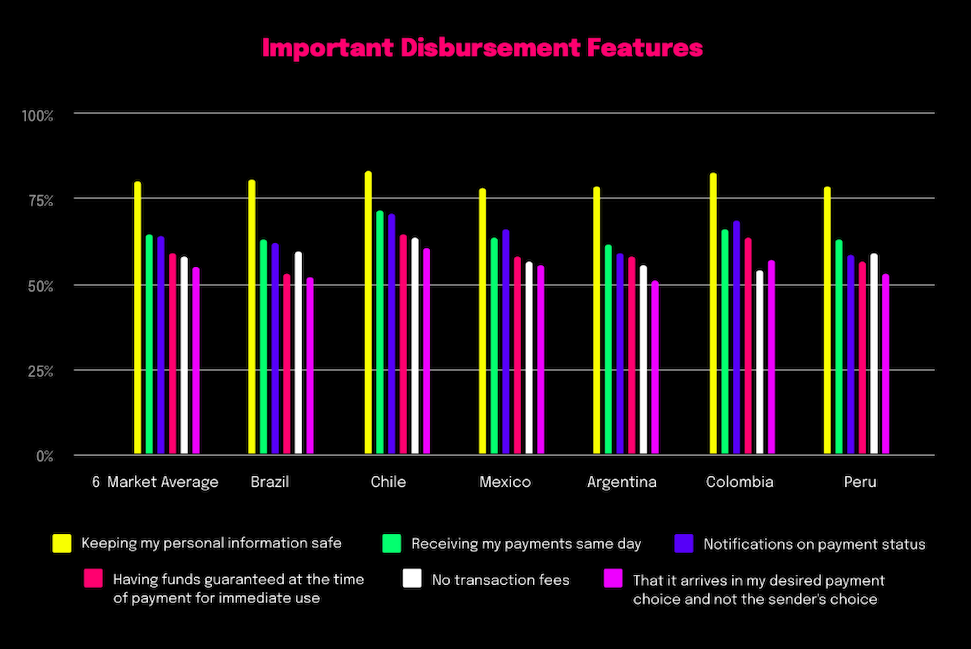New data from Argentina, Brazil, Chile, Colombia, Mexico and Peru provides country-by-country analysis on preferred methods for workers to be paid; uncovers growing opportunity for global businesses to reach LATAM consumers in an increasingly digital world.
25 OCTOBER 2022 – San Francisco – Rapyd, the leading fintech-as-a-service partner, today released its 2022 Latin America State of Disbursements Report. The report analyzes the findings of a survey Rapyd conducted in June 2022 to more than 3,000 online consumers in Argentina, Brazil, Chile, Colombia, Mexico and Peru on their most-commonly used and preferred ways to get paid. The findings illustrate that with the region’s hypergrowth in local and cross-border business, LATAM is emerging as a primary market for expansion by global businesses. Contractors, workers and suppliers are seeking quick and secure payouts and disbursements in their preferred method across multiple countries. The report shows that:
Traditionally underserved by banks, LATAM beneficiaries have adopted an open mind to fintech and are showing a clear preference to digital methods to receive payments
- LATAM consumers want to receive direct digital payments. Over 50% of respondents prefer to receive their earnings by direct bank transfer.
- Direct bank transfers are also preferred for other payouts such as rental income, tax refunds, loan payouts and commissions. eWallets and wire transfer are another preferred way to receive payments for personal gifts, repayments, commissions and many other payouts.
- Even as these various digital payments soar, cash is still one of the most common ways to receive payments. Over 20% have received payment via cash for various payouts in the past three months.
- Nearly 40% of consumers receive payments regularly for freelance and gig work. Many of these gig workers may not have access to traditional bank accounts and are more open to getting paid by direct, same-day digital payments through ewallets or other methods.
Even as consumers open up to digital payments, offering fast and secure payments is crucial for global businesses to reach LATAM workers:
- Over 40% of LATAM consumers think of themselves as “explorers” of smart payment technology and are open to exploring innovative technology. Only 13% of consumers surveyed identified as “laggards” regarding their own adoption of fintech applications.
- As digital payments grow, security becomes increasingly important for consumers. 76% of LATAM consumers say receiving payments safely and securely is the top priority.
- The other most important features of disbursement methods are receiving same-day payments (61%), and receiving notifications on payment status (61%).
Rapyd Chief Marketing Officer Marc Winitz says: “Finally the world is seeing what we’ve known to be true for years – Latin America is a hotspot for fintech innovation. When it comes to both paying and getting paid, Latin American consumers operate with a digital-first mindset – and they have already adopted innovative practices that the rest of the world is still catching onto. Localized payout and disbursement in preferred local methods continue to be one of the most requested capabilities we are seeing across the region and our research confirms this.”
While only 37% of Latin American consumers have a traditional bank account, 60% consider themselves early adopters and explorers of fintech technology. Mr. Winitz added, “This unique market dynamic creates a huge opportunity for regional and global businesses that want to expand their reach and presence across Latin America. Looking ahead, the businesses that succeed and win in the region need to understand and accommodate LATAM consumers expecting to receive payments in their preferred methods with an emphasis on speed, security and data protection.”
Download the full report here.
Survey Methodology
In June 2022 Rapyd conducted a research study to 3,088 online consumers in Argentina, Brazil, Chile, Colombia, Mexico and Peru to understand the financial habits and disbursement method choices, considerations and preferences of consumers in these six key Latin American markets. All respondents made an online purchase in the previous month and were nationally representative across age and income scale.
